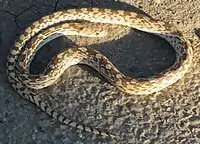Pituophis catenifer affinis
Pituophis catenifer affinis, commonly known as the Sonoran gopher snake, is a nonvenomous subspecies of colubrid snake that is endemic to the southwestern United States. It is one of six recognized subspecies of the gopher snake, Pituophis catenifer.[5]
| Pituophis catenifer affinis | |
|---|---|
 | |
| Scientific classification | |
| Domain: | Eukaryota |
| Kingdom: | Animalia |
| Phylum: | Chordata |
| Class: | Reptilia |
| Order: | Squamata |
| Suborder: | Serpentes |
| Family: | Colubridae |
| Genus: | Pituophis |
| Species: | |
| Subspecies: | P. c. affinis |
| Trinomial name | |
| Pituophis catenifer affinis (Hallowell, 1852) | |
| Synonyms | |
Geographic range

It is found from central Texas across the Southwestern United States to southeastern California, Arizona, and south into the northern states of Mexico.
Description
Adults average 127–183 cm (4.17–6.00 ft) in total length. The maximum recorded total length is 234 cm (7.68 ft).[3]
The saddle-shaped dorsal blotches are reddish brown,[1] except for near and on the tail, where they are dark brown or blackish.[3]
The rostral is about as long as it is broad, not elongated as in other Pituophis subspecies.[6]
Habitat
It primarily inhabits the Sonoran Desert ecosystem of the Southwest USA, and into northern Mexico.
Diet
They feed on small rodents, hence the common name gopher snake.
Behavior
They are moderately defensive but can be tamed, and become very gentle. They have hard tough skin on their noses used to burrow into gopher holes and the burrows of other rodents. During the winter they brumate. They invade gopher holes and holes of other burrowing rodents and eat what they need to stay alive in the invaded burrow.
Reproduction
P. c. affinis is oviparous. Adult females lay 7-22 eggs in July or August. The eggs average 51 mm × 35 mm (2.0 in × 1.4 in). The hatchlings are about 40 cm (15.5 in) in total length.[2]
References
- Schmidt, K.P., and D.D. Davis. 1941. Field Book of Snakes of the United States and Canada. G.P. Putnam's Sons. New York. 365 pp. (Pituophis sayi affinis, pp. 163-164 + Figure 46. on p. 161.)
- Wright, A.H., and A.A. Wright. 1957. Handbook of Snakes of the United States and Canada. Comstock. Ithaca and London. 1,105 pp. (in 2 volumes) (Pituophis catenifer affinis, pp. 593-597, Figure 172. + Map 46. on p. 589.)
- Conant, R. 1975. A Field Guide to Reptiles and Amphibians of Eastern and Central North America, Second Edition. Houghton Mifflin. Boston. 429 pp. ISBN 0-395-19977-8 (paperback). (Pituophis melanoleucus affinis, p. 201 + Map 147.)
- The Reptile Database. www.reptile-database.org.
- Integrated Taxonomic Information System (ITIS). www.itis.gov.
- Smith, H.M., and E.D. Brodie, Jr. 1982. Reptiles of North America: A Guide to Field Identification. Golden Press. New York. 240 pp. ISBN 0-307-13666-3 (paperback). (Pituophis melanoleucus affinis, p. 186.)
Further reading
- Hallowell, E. 1852. Descriptions of new Species of Reptiles inhabiting North America. Proc. Acad. Nat. Sci. Philadelphia 6: 177–182. (Pityophis affinis, p. 181.)
External links